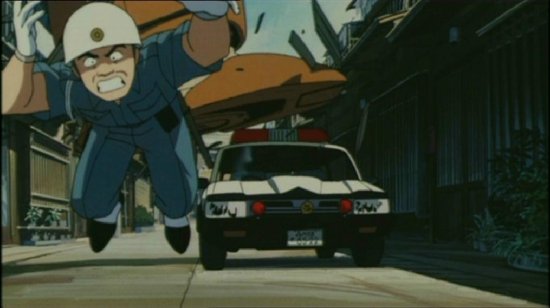Patlabor The Movie: Limited Collector's Edition
Introduction
As I type, Mamoru Oshii's masterwork, Ghost In The Shell is back in UK cinemas, sporting a new 2.0 visual upgrade, a new soundtrack, and all fresh and shiny for the 21st Century. It will be out on DVD and Blu-ray by the end of the month as well, and given my appreciation of all things cybernetic, I have made a space in my schedule to take in the film. But you don't dive into these things cold; you need to warm up a bit first. I recall reviewing a Urusei Yatsura movie or two, and was surprised to find Mamoru Oshii listed as the director. I likened it to Ridley Scott directing a Carry On movie prior to Blade Runner, but I had forgotten a vital entry in Oshii's filmography, Patlabor. Patlabor was the OVA series that Oshii directed at the hind end of the eighties that spun off three feature films, a further OVA series, and a television series proper that stretched to 47 episodes. Maybe there's an explanation here of how a director went from directing madcap anime romantic comedy, to philosophical musings on the nature of existence, told from a cyberpunk sci-fi perspective. I haven't had a lot of satisfaction from the mecha genre, which is why up till now, my only exposure to Patlabor has been a vaguely remembered, late night television showing of Patlabor 2, which I rapidly fell asleep to, some fifteen years ago. Having something like my tenth viewing of Ghost in the Shell to look forward to, gave me the motivation I needed to sink my teeth into something of Oshii's that I had never properly seen before.
It turns out that Ghost in the Shell isn't the first example of Oshii's tinkering with his old movies. Patlabor The Movie was released in 1989 followed 3 years later by the first sequel. For a long time in the UK, Manga Entertainment held the rights to the two films; they initially released them on video, and then when the technology became available on DVD. Of course Manga's DVDs were simple ports of the VHS versions, letterboxed with the original Manga soundtrack. However, around the end of the nineties, with DVD gaining ground, and the advent of multi-channel sound in living rooms, Mamoru Oshii decided to revisit his two Patlabor films. The original sound elements for Patlabor 2 were still extant, and creating a 5.1 mix for them was a relatively easy matter. Not so for the first Patlabor film, for which only a down-mixed track remained. So in 1998, Mamoru Oshii revisited Patlabor with an eye to bringing it into the 21st Century. This meant re-recording the sound for the entire film, from sound effects, to music, and even dialogue. The original actors were brought in to redub the entire feature, Kenji Kawai reworked his music, and a whole new Sound Renewal Patlabor was born.
Then after another 8 years, someone invented High Definition Television. When it came for Patlabor to debut on the new format discs, it became the ideal time to revisit the visuals as well, although really just to clean the print up for remastering. The Patlabor films have been released in Japan on both HD formats, but in the US Bandai was to release the films through the Honneamise boutique label. Alas, they chose the HD-DVD route, a format that died before the films could be released. However, the HD masters meant that new DVDs could be created; the new sound mixes could be brought over to the US, and what better time to lose the old Manga dub and create new English dubs for the films. So in 2006, Bandai Visual through Honneamise re-released the seminal Patlabor films, all spruced up with 5.1 channel sound, cleaned up visuals, and anamorphic for the first time in the West. Of course, being Bandai Visual, we got the option of buying just the films by themselves, or special super limited editions, with funky packaging, and extras to salivate over… for a premium. Where Bandai leads, Beez follows, and their Patlabor Limited Collector's Editions were even more limited than those in Region 1. Where the US fans got 10000 apiece, we in the UK got only 1000 of each.
You're probably wondering why I'm reviewing the Patlabor Limited Collector's Edition now, two years after it was released in the UK. In a slightly disheartening reflection of the genuine state of the UK anime industry, even a limited run of 1000 shiny exclusive packages still haven't found homes as yet. Believe it or not, you can still find these sets for sale online, and at a laughable fraction of the recommended retail price.
The year is 1999, in an alternate Tokyo according to the blurb on the box, but the near future when this film was made. All of the city's energy is invested in Project Babylon, the creation of artificial islands and dams, and the reclamation of thousands of square hectares of habitable land area, to allow for the expansion of the city. Such a monumental undertaking would have been impossible, were it not for the Labors. Giant humanoid robots now do much of the heavy lifting in the city, 8000 of them piloted by trained professionals now do the work of what would have taken many times that number in manpower alone. The output by these powerful machines ensures that Project Babylon runs to schedule.
Of course not every Labor is used responsibly, some people use them for criminal activities, which is where the Patlabors come in. The Special Vehicle Section of the Tokyo Police force come equipped with Labors of their own, with which they detect and combat Labor crime in the city. The 2nd Unit is the unconventional department, whose methods leave much to be desired, and is seen as a dumping ground for those officers who don't quite fit in elsewhere. Suddenly, Labor crime takes on a chilling new dimension. Now Labors are running amuck in the city, causing massive devastation, but with no human pilot present. The spread of the crimes can be traced back two months, to when the new Hyper Operating System was introduced to the Labors as a routine upgrade. The HOS was supposed to make them smarter, faster easier to pilot, and more productive, and it wouldn't be politically tactful to find a major manufacturer at fault. Politics doesn't stop the 2nd Unit though, but their investigation looks dead-ended when it transpires that HOS's creator, Ei'ichi Hoba killed himself two months ago. And the worrying thing is that the 2nd Unit's Labors have been upgraded to HOS.
Picture
Patlabor gets a 1.85:1 anamorphic transfer. It's a standards conversion again, but a really quite good one. Ghosting, judder, and softness are all absent. You'll have to pause the disc, and probably skip forward a few frames before you spot the interlacing. If only all NTSC-PAL conversions could be this good. Patlabor is a 20-year-old film now, but it looks remarkably spry for its age. The image is clear and sharp, and absent any significant print damage. The filmmakers opted for a soft, autumnal palette, and the colours are very realistic. The animation is still stupendous, more so when you consider that this would have been accomplished on cel alone, with no computers involved at all. The use of shadow and light is extremely effective; character designs are pleasant and memorable, while the film really comes to life with the Labors. You see these machines as just that, machines, vehicles that people operate. You certainly don't anthropomorphise them, there's no indication of life to these metal beasts, they're just the two-legged equivalents of forklift trucks, or cranes, or tractors. The only nitpick I have with the film are the black levels, which just aren't good enough at times, and consequently darker scenes lack definition, while the greys and blacks seem to blend into each other.
Sound
As mentioned, you have a choice between DD 5.1 English and Japanese, with optional English subtitles. The surround is very effective, bringing across the action well, while Kenji Kawai's music is shown off at its best. I didn't see the original version, but I have experienced enough Manga Video dubs in my life to be profoundly grateful for the new Bandai dub, which is well cast and well performed (judging from the few minutes I sampled at least). My preference as always is for the Japanese version, and I found it to suit my usual expectations. I wasn't fond of the subtitle font used though, which looked a little too rough at the edges for my taste.
Extras
The Limited Collector's Edition is a brick of a boxset. I bought the Patlabor 1 and 2 twin set, and it had to be delivered by van. Postmen get hernias too. Patlabor the Movie is packaged in a hefty silver cardboard construction, bestrewn with Honneamise and Bandai logos, with some really splendid artwork to ogle. A label that regionalises the set to the UK covers the backside and bottom, and it's here where you'll find the Beez logo, the BBFC rating, and the Region 2 mark. This is peel-off-able, as is another BBFC sticker at the front. There is another label at the top that tells you just which of the 1000 sets you have.
Inside the case, you'll find your DVDs and two books.
The 300-ish page book of storyboards is just that. It's nicely covered in sturdy, silver, embossed card, and inside you'll find the whole movie in storyboard form, annotated in English (probably translated from the Japanese), giving you an idea of just what the director intended. There's a glossary at the back to help you decipher the filmmakers' jargon, as well as a proviso that most of the jargon is out of date, following the switch from cel to computer animation.
Patlabor: The Movie Archives is a 180-ish page book that is the real delight of this set. Everything you want to know about this film, from the production, the concept, the story, is all examined here. There are interviews with the director, and the composer. There's input from many of the players behind the film, including the voice cast. There's a look at the location photography, the concept art, and the OVA, and television series to give you a better grounding of the Patlabor universe. There's also much, much more for you to take in, as I've really just scratched the surface. The cover art is quite special, and it's filled with stills, diagrams, photos and concept art in black and white, and colour.
The discs are contained in a card-bound book style package, although the discs are held in two digipack inserts, glued to the card. The two inserts also click together, stopping the book from falling open.
Disc 1 contains the film, as well as the teaser and theatrical trailers, as well as two TV spots.
Disc 2 is exclusive to this Collector's Edition, and contains the 1989 Making of Patlabor Documentary. It's 31 minutes in length, although divided into easily accessible chapters, and offers insight into the location scouting, the story, the animation and the design, the sound and music, and much more besides. It could be a little more detailed, and really just skims the surface of the Movie Archives book, but is a useful addition nonetheless.
Conclusion
All new soundtracks, cleaned up and remastered visuals, and a Limited Collector's Edition that looks worth its weight in gold, I was expecting something special from this film. In the end it was all a little anticlimactic. There is a lot to appreciate about the first Patlabor film, visually it's stunning, the music is evocative, and the story is deep and thought provoking, as well as socially relevant. It's just that it's too darned long. It's a story that could easily have been told in half the time, losing little of the nuance, none of the character progression, and none of the depth. It's very much a television episode writ large, with the director's indulgence for the Tokyo cityscapes acting as filler. As a result, Patlabor is a languid and leisurely paced techno-thriller, lacking in suspense and adrenaline, and by the time the action filled conclusion does arrive, the impetus to drive that action just isn't there. I remained detached from the events in the film, viewed it dispassionately and that hurt it somewhat.
I think Patlabor probably makes a bigger impact on those who saw the OVA series first, and have come to know the characters through that series. The character development is a little lacking in the film, and other than the central duo of Noa and Asumi, the supporting cast remain pretty much as ciphers. I did however see how Patlabor slots between Urusei Yatsura and Ghost in the Shell. This truly is a canvas for the director to work with some deep ideas and concepts, the relentless march of progress, the clash between old and new, the pervasive annoyance of politics, and the insidious infection of terrorism, as well as biblical allusions to the Tower of Babel. Yet the characters of the 2nd Unit, are drawn larger than life, prone to exaggeration and wild takes, and a fair bit of goofy comedy to boot. There's none of the understated thoughtfulness of Ghost In The Shell, and certainly none of the philosophical soliloquies of Innocence. Instead the character antics in Patlabor contrast with the sombre settings, and the serious storyline.
Set ten years into the future, Patlabor is a remarkably prescient film though, although looking ten years ahead is fairly simple to do. The constant need for living space around Tokyo must have been obvious even then, and as mentioned in the Archive, some of the engineering projects posited here, did actually come to pass. Where Patlabor really strikes a nerve is with its depiction of terrorism at the end of the century. Ei'ichi Hoba is a motiveless character, or rather we are asked to divine his motives from the extended sightseeing tour a couple of detectives make of his past life. This ambiguity and difficulty to understand certainly bears resemblance to our own inability to understand terrorist motives today. And his suicide at the start of the film, choosing not to even see his plans come to fruition, is chillingly accurate. His plan is insidious and again, looks forward to the modern day. He introduced a flaw into the Labor operating system that induces them to go berserk when they pick up a sound of a certain frequency. That sound is produced when the wind whistles past those tall modern buildings that are a sign of modern progress, the very same progress that has prompted his violence.
Once again, what really impressed me about this film was the fact that the Labors were treated as machines, no different from a car or a truck. With the exception of Noa, who for some reason has become fond of 'Alphonse', for everyone else they are just tools. It makes a refreshing change from the majority of anime where giant robots have names, personalities, and you're the weird one for not shedding a tear when their paintwork gets scratched. Of course even in the real world there are people who have a favourite computer that they have personalised just so, and people who think that Volkswagen Beetles should have names, which explains Noa's attitude in the film.
Patlabor is a colossal achievement, it broke new ground in animation, and coming from 1989, it still holds up well 20 years later and could easily qualify for the descriptive 'timeless'. The level of detail, the thought that has gone into bringing a vast metropolis to life, the matter of fact appreciation of futuristic technology, the omnipresent ubiquity of Labors as an commonplace tool make this world seem lived in, and all the more real. It's just that the film is too long at 99 minutes, for a concept that is better suited to 45. But look, that rubbish dump is so evocative; let's linger here for a while.
I'm glad I have seen Patlabor, just to see where it stands in the evolution of anime. But I wouldn't advise you to rush out and grab a copy if you want a quick blast of entertainment. The Patlabor Limited Collector's Edition, and Patlabor 2 Limited Collector's Edition are also available in a twin pack, which is how I got mine. You can also buy the films as vanilla single disc releases.













































































Your Opinions and Comments
Be the first to post a comment!